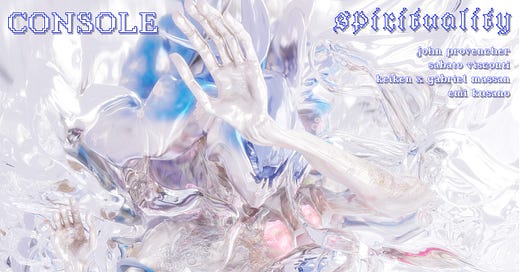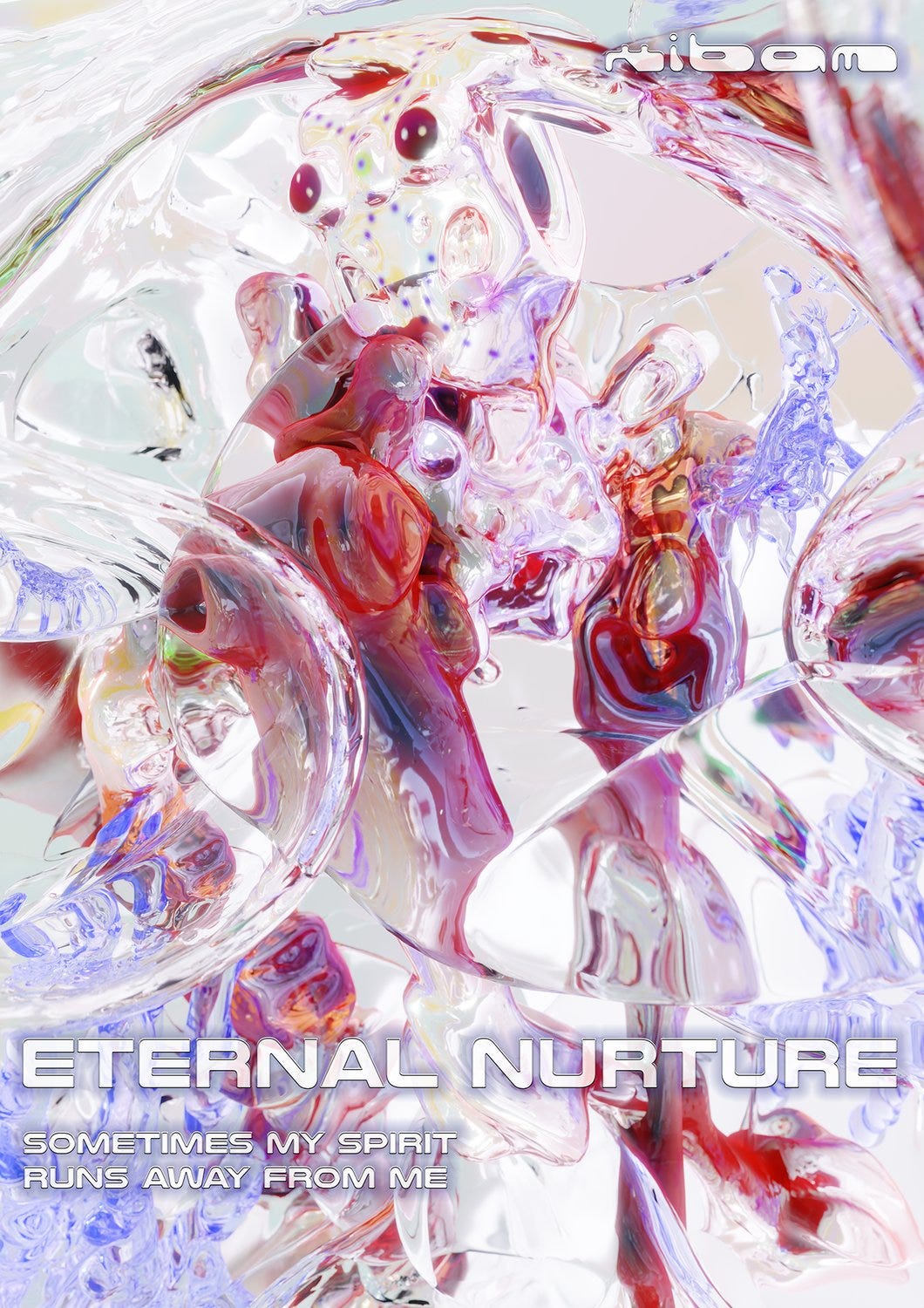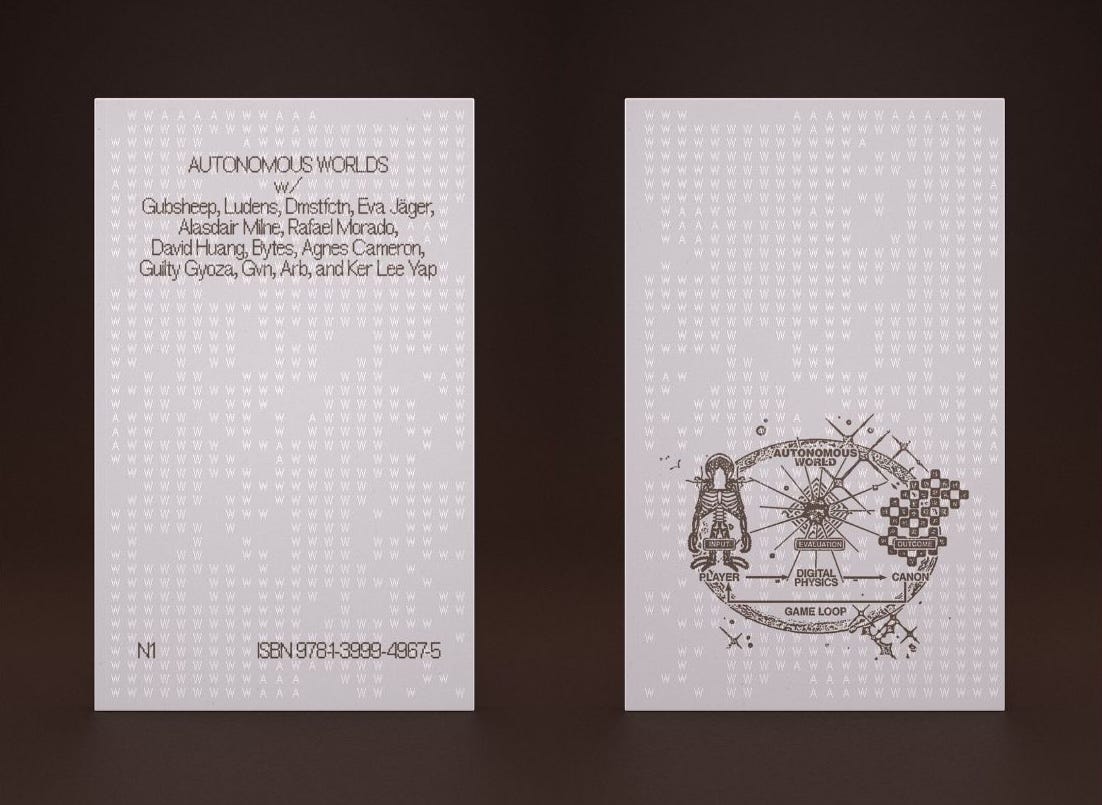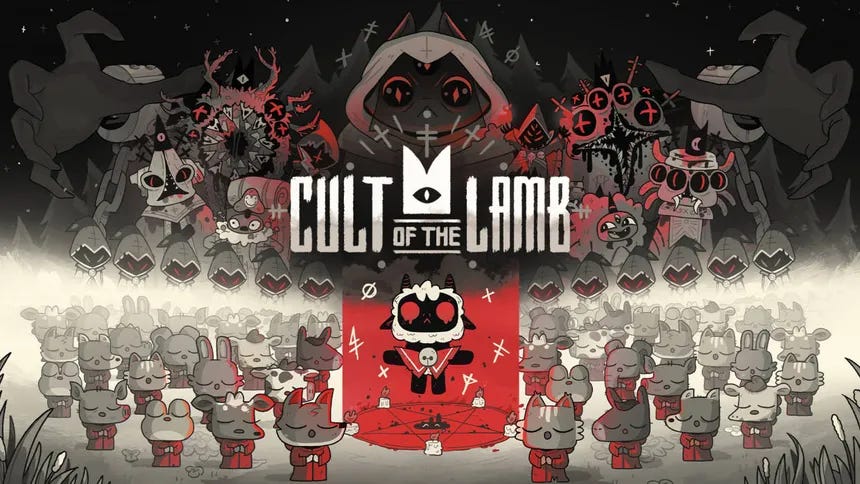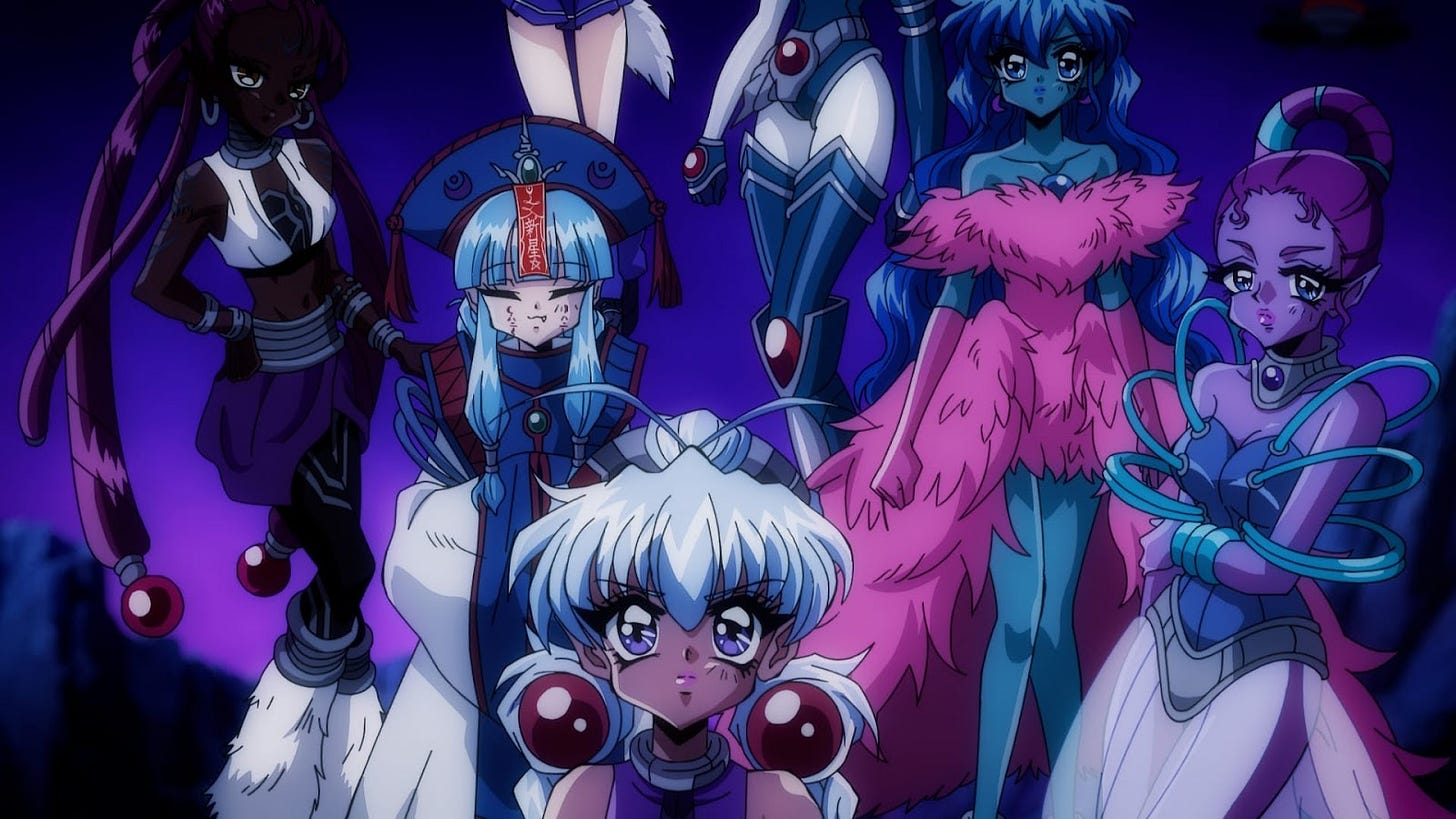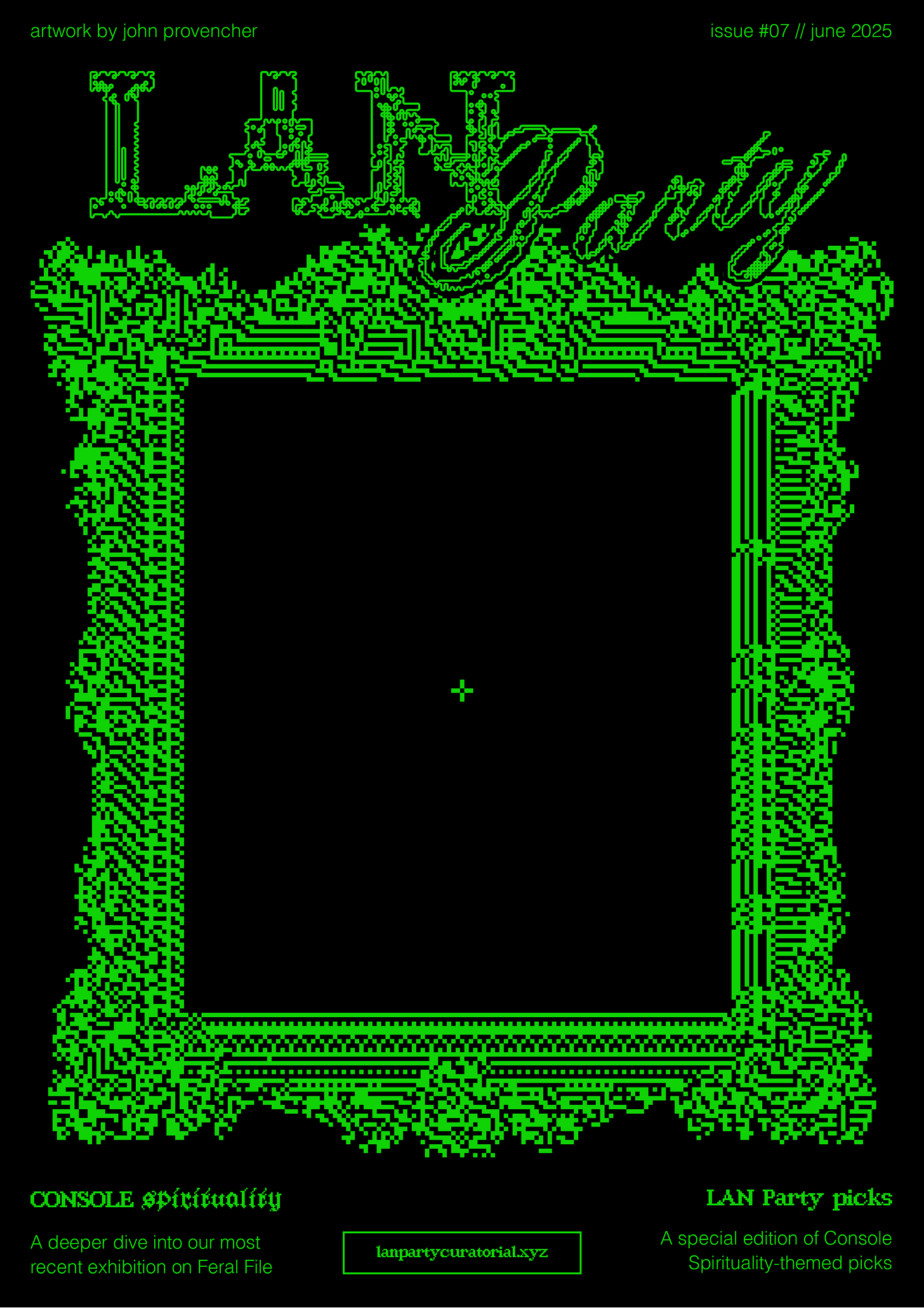Welcome to BLOG by LAN Party, the monthly newsletter by Vienna Kim & Benoit Palop that investigates and critiques how we engage with curation, art & culture in the digital and onchain era. This month’s issue is a special one, as we deep-dive into our latest exhibition, Console Spirituality, presented by Feral File in partnership with Rhizome. This exhibition, which has been brewing for a year and a half, interrogates video games as a powerful cultural phenomenon and explores how artists take cues from games to glitch, subvert and reimagine our concrete realities to propose speculative modes of being.
If you would like to support our work, the best way to do so is to subscribe to our Hypersub or Substack and share things that you like in our newsletter on social media. You can even earn 10% on all referrals on Hypersub. :-) This issue is a long one, so you’ll want to read it via the Substack app or on desktop. Let's dig in.
One third of our planet plays video games. As of 2025, there are an estimated 3.32 billion people who play video games all over the world. Yet, despite the fact that artists have been using and taking inspiration from games as early as the 1970s, video game art has remained criminally underrepresented in the art world.
In our most recent exhibition, Console Spirituality, hosted on Feral File and presented in partnership with Rhizome, we set out on a quest to investigate the transformative power of video games–in art and in life. If gaming is one of the most prevalent, powerful cultural forms of our time, analysis and interrogation upon its societal, economic, political and even spiritual implications are required. We invited five artists from across the globe to do just that. Spanning 3D, AI, algorithmic and glitch techniques, the artworks in Console Spirituality represent divine visions of video game-powered worldbuilding that create the conditions for individuals to transcend lived reality, arguably ascending to ‘truer’ versions of themselves.
The exhibition is in and of itself framed as a quest, where each artist’s body of work composes a ‘level’ within the structure of the show. Each ‘level’ is an imaginary spatial and symbolic realm that guides the viewer to console spirituality–virtual nirvana–beginning in an underground dungeon maze and winding through various biomes before attaining a spiritual apotheosis in the ethereal Fractal Plane. We encourage viewers to really sit with the works at each level, reflecting upon how their technical, aesthetic and conceptual qualities relate to the imagined geography of each environment and, further, how this maps onto a narrative of a personal spiritual journey.
Now, it’s time to press start.
Level 1: Dungeoneer
We begin in the depths of a labyrinth. Dungeoneer by John Provencher is a series of 64 works in a self-running program that navigates a generative Doom-inspired dungeon. Each piece serves as a portal to a specific floor, composed of a distinct maze that is adorned with a skin displaying the collector’s unique minted artwork on the walls. The viewer-player clicks once to activate the experience. From there, they adopt the position of a first-person shooter and are led through a programmatic path.
Dungeoneer plays with the tensions of active versus passive viewership in ways only a video game-inspired work can. When viewing the work, the viewer-player almost instinctively wants to WASD their way through the virtual space, but Dungeoneer denies this possibility. Despite strong visual references to games such as Doom and Wolfenstein 3D, Provencher also cites the Windows 95 3D maze screensaver as a key inspiration for the work, expressing his interest in ‘how good it felt to just watch something move around forever. No goal. Just movement.’ Agency is thus suspended, and the viewer-player is instead transfigured as an NPC (a Non-Playable Character). Their only recourse to action is to initiate the self-running program and watch the memory of the run unfold before their eyes.
The series also presents an interesting method of reimagining a virtual exhibition space. The conceptual structure of Dungeoneer is inspired by a diagram of a Diablo dungeon, which appeared to the artist to look more like a museum than a video game map.
For Dungeoneer, Provencher aimed to present work online that didn’t resemble a website or gallery viewing room–which is the typical presentation for digital artworks–but instead as an engine for images. Raycasting, the rendering technique that visualises 3D space within a 2D map that was used in early Doom video games, was a perfect response to this need. Each of the 64 artworks in the series is generated with a seeded algorithm that renders the 3D appearance of the floor, and then navigates through it within the dungeon-cum-museum space.
As for the pixel paintings that decorate the walls of the dungeon, they are stored as .json files, which are what computers use to remember things. Each technical element of the work, from the fact that the viewer cannot actually ‘play’ the game to the storage system itself, thus combine conceptually to convey a nuanced–almost hidden–message around agency, memory, and the NPC-ification of society today.
Level 2: Data Pilgrims
If we imagine that Dungeoneer represents the ‘dungeon/tower’ portion of the above diagram, then Data Pilgrims represents that exterior plain that leads to the ‘town’. We have surfaced from the depths of the labyrinth and have attained the Glitch Plains–this is Level 2: Data Pilgrims.
Data Pilgrims is evocative of the slow, atmospheric experience of walking simulators, a specific genre of video games that focusses on exploration, narrative, and interaction with the environment. Many famous walking sim games, such as Death Stranding, often evoke a spiritual or at least deeply emotional experience for players, simply within the ritual of walking through a sublime (sometimes hostile) landscape and the mental/physical conditions that evolve through this act. Similarly, Kusano’s Data Pilgrims tugs upon this energy of mystery, personal development, and meditative reflection, as we witness anonymous pilgrims wander through the Glitch Plains in a quest for nirvana. Throughout their pilgrimage, they cross paths with spirits (kami) and supernatural beings in the form of animals (yokai) that loom across the virtual space as guides… or omens.
Kusano’s use of artificial intelligence in the creation of this series adds to the esoteric and layered nature of the work. Each image is created through repeated cycles of AI image regeneration and recombination, which cause the images to ‘hallucinate’—distorting original meanings and aesthetics from the ukiyo-e painterly tradition that the artist draws inspiration from, and generating entirely new visual realities. Through its iterative and transformative process, the series highlights both the creative potential and the existential risks of artificial intelligence. Uncannily, there is a resemblance to the repetitive act of engaging in a religious ceremony or ritual, repeating certain motions and layering their significance until one attains a spiritual breakthrough.
Our pilgrimage having come to an end, let us transcend to the Heavens.
Level 3: Angelcores & Heavenly Sprites
Angelcores & Heavenly Sprites is a celestial realm pixelated by time and refracted through vintage gaming systems. Here, Sabato Visconti turns to the angelic figures hidden in the games of beloved (and now nostalgic) third- and fourth-generation consoles like the NES, Super Nintendo, and Sega Genesis, uncovering the divine where we least expect it: not in perfection, but in collapse.
While much of our cultural imagination around angels comes from European Christian traditions, with robed messengers and radiant halos, the broader history of the angelic is far more complex. In the past few years, online meme culture has extended the idea of ‘biblically accurate angels’, creating images of those non-human, ethereal entities described in sacred texts as spinning wheels, flames, or beasts with countless eyes. Angels depicted in video games from the 1980s-90s hold a similar richness of representation (though often less creepy). Games such as ActRaiser, Wings of Wor, Spiritual Warfare, Chubby Cherub and Legendary Wings interpreted angels in different ways: warrior-gods, cherubic cuties, winged bosses, divine projectiles. These angels were not always sanctified. Sometimes they were goofy. Sometimes they bugged out.
Visconti leans into that glitch. Using ROM-corruption techniques, looping GIFs, and image degradation, he extracts the angelic essence trapped within these forgotten worlds. The result is a body of work where divine imagery emerges through decay, and broken graphics become mystical signals. Dialogue boxes collapse into cryptic tongues. Game logic disintegrates. The angelic is no longer pristine, but modded.
This approach becomes a ritual of interruption. Here, Visconti’s work enters into conversation with Legacy Russell’s Glitch Feminism, Bo Ruberg’s ‘Playing to Lose’, and Rosa Menkman’s ‘Glitch Studies Manifesto’. These texts not only reframe failure and error as creative, liberatory acts, but also use glitch to subvert and destabilise dominant conceptions of societal norm. In this vein, Angelcores & Heavenly Sprites positions glitch as a method of exploring the spiritual beyond Euro-American Christian dominance, whilst also leaning into its longstanding relation to queering tech, undoing control, and conjuring new ways of seeing and being.
At this level of our quest, the sky is not whole. It fractures. But in that instability lies potential. The angelic does not descend from on high. It rises from failed saves.
Level 4: Omoiyari
What happens when the Heavens glitch and fracture right open? We have no-clipped into the Fractal Plane, a liminal zone beyond the binaries of Heaven and Hell. Here, we meet Uxkme and Xibam, two spirits born from a collaborative series, Omoiyari, by artist collective Keiken and Gabriel Massan.
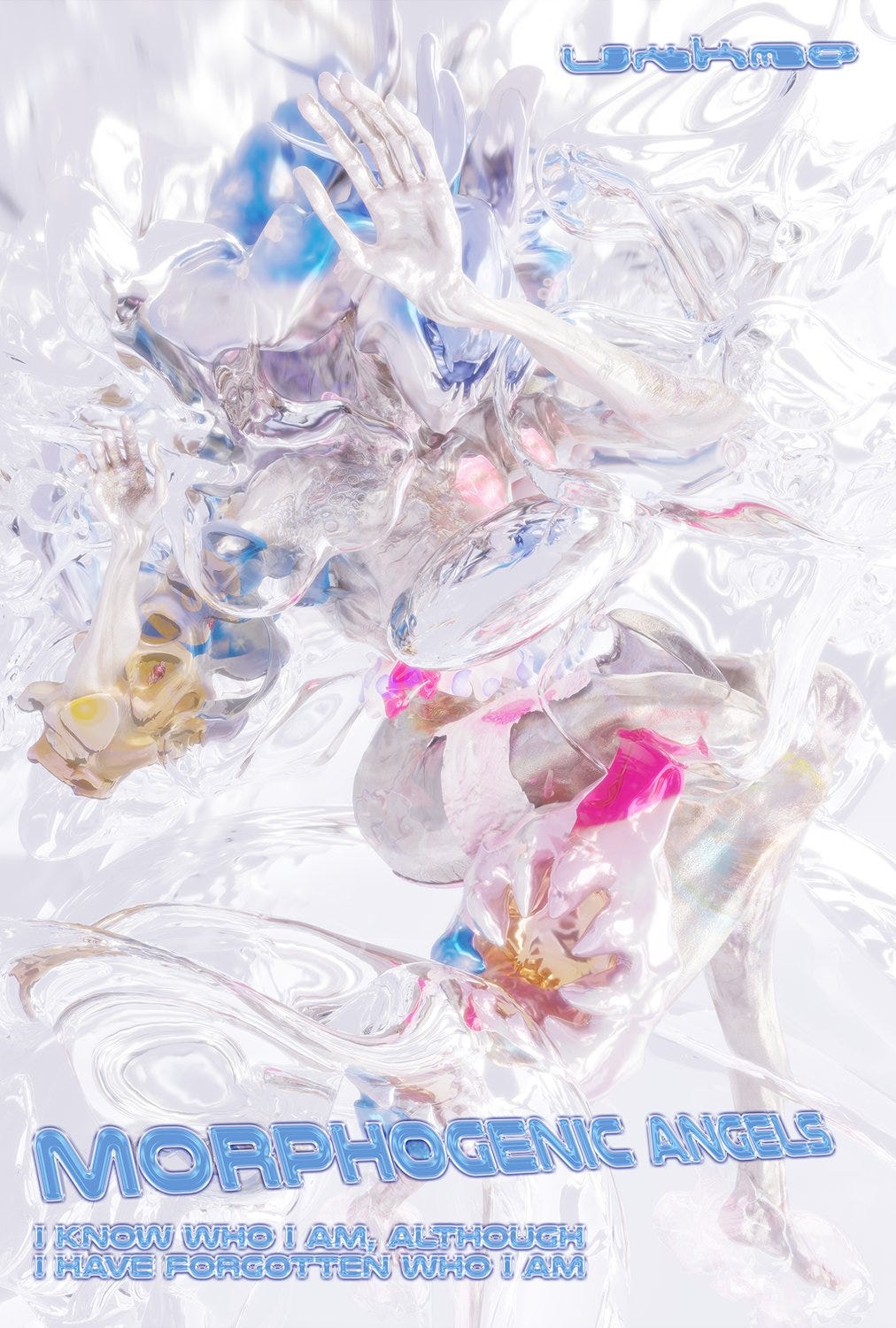
In Omoiyari, these ethereal avatars are captured in a freeze frame mid-motion in a non-descript atmospheric environment. The only visual elements that anchor them to our world are the slogans that accompany them in the style of a video game advert. Originally commissioned and exhibited by The Photographer’s Gallery in London in 2022, the context of these works displayed a stone’s throw away from Oxford Street–the capital’s commercial nucleus–provided a point of tension and contrast that runs counter to the delirium of consumerism. Omoiyari intentionally uses the visual language of commercialism to subvert it, replacing buzzy marketing slogans with messages of tenderness, compassion, longing and love. For example, Uxkme (which means ‘old woman’ in Téenek) is a fragile avatar trapped in the thick gel of time. They struggle to remember themselves but grasp on to the muscle memory of their spirit: ‘I know who I am, although I have forgotten who I am’. Xibam (which means ‘brother’), is a cute sibling spirit with eternal nurturing energy, who acknowledges that sometimes their own spirit may evade them: ‘Sometimes my spirit runs away from me.’
The added softness, deeper meaning and nuance of these works and their messaging encourages viewers to look beyond our limited capitalistic reality and rather examine the depths and complexities of being a spirit within a body. Uxkme and Xibam radiate love, but they also acknowledge, and perhaps even mourn, their limitations.
Beyond the binaries that define and constrict our lived reality today (death vs. life, heaven vs. hell, happy vs. sad, male vs. female, hard vs. soft…), the avatars that compose Omoiyari suggest that, perhaps, one’s personal development towards attaining virtual nirvana consists not in winning the game and going for gold. Instead, it lies in the malleability and subtleties of life’s experience, from the depths of the moments when we feel lost (Dungeoneer), in the wandering and journeying when we attempt to find our way (Data Pilgrims), and in the moments of high, even when we feel it may be cracking and slipping through our fingers (Angelcores & Heavenly Sprites).
End game
Console Spirituality is an exhibition about defying lived reality by developing, glitching, modding, hallucinating, and summoning new realities into being. It denies binaries such as winning and losing, and adds nuance to video game and digital art culture through diversified explorations of identity, worldbuilding, and spirituality. Together, the works in Console Spirituality guide us through various levels of experience to attain a speculative (enlightened?) way of being. They are also a testament to the deep, emotional connections people can develop with and through video games. Using worldbuilding techniques to include viewers in their artworks as both active agents and NPCs, the artists take cues from games to deepen the relationship between artwork and viewer. By playing (and consequently implicating themselves in) the artwork, viewers are absorbed into these artists’ worlds, and are ultimately prompted to contemplate and pursue their own virtual nirvana. This is the end game. This is Console Spirituality.
⚔️ View the exhibition and collect here ⚔️
LAN Party Picks
Vienna’s picks of the month:
To read: Autonomous Worlds N1
It sounds dramatic, but it’s true: I think Autonomous Worlds N1 is the book that has impacted me the most so far this year. Mostly because it’s opened up an area of research that is deeply fascinating for me, and that I’d like to dedicate a good chunk of my time on: worldbuilding via onchain computation, ie: how the blockchain creates specific means and affordances for creating new worlds, especially autonomous ones that do not rely on a single entity for its perpetuation. For me, my interest lies in how we research, share and validate information. If life online feels so fractured, I wonder if it’s because we lack what the book describes as concrete inter-personal realities – sources of truth that we can all rely upon in the digital realm (like physics or gravity, in our AFK lives). Autonomous Worlds N1 provided the seed of this idea that I hope to develop in the future.
Besides my personal takeaway, the book explores the blockchain and onchain computation as a novel medium for virtual worlds, specifically looking into the use case of video games. With essays penned by engineers, game designers, artists and researchers, the book includes cultural analysis and speculative examples of how we can use the blockchain to formulate worlds in new ways.
To see: Berserk & Pyrrhia: Contemporary and medieval art
John Provencher (this issue’s Artist of the Month) highly recommended this exhibition in Paris, so I’m going to go!! Berserk & Pyrrhia is an exhibition that spans two locations–Le Plateau and Les Reserves–that explores the dialogue between medieval art and its integration into pop culture and contemporary art today. The show at Le Plateau focusses on the figure of the berserker, the legendary (often bare-chested) warrior who charges into battle in an enraged trance. The figure has reappeared in film, video games, manga and rap music within contemporary culture. Pyrrhia, on the other hand, the character in-focus at Les Reserves, is a butterfly that gave its name to an imaginary island, described in The Wings of Fire by Tui T. Sutherland. Whilst Berserk explores mystical and romantic iconography from 19th century reinterpretations of the medieval period, Pyrrhia explores and develops upon depictions of bizarre, anthropomorphic creatures and medieval bestiary.
What’s fascinating about this show is that it juxtaposes works from the medieval period, on loan from various collections and institutions, with contemporary artists appropriating and remixing the epoch’s visual language and motifs. From what I’ve seen in the photos John sent us, there are video game works, sculptural wall triptychs that appear almost alien-like, and mixed-media pieces that figure mystical creatures… so I’m excited to check it out!
To play: Cult of the Lamb
I’m about 75% of the way through Cult of the Lamb, the popular rogue-like game that came out in 2022. Since our Picks of the month are all Console Spirituality themed, what better than to include a game that allows you to literally create your own cult?!
In Cult of the Lamb, you play an adorable lamb that is saved from a sacrificial death by a god, The One Who Waits, who has been banished and chained to the underworld. In exchange for your life, you must establish a cult in his name. Half of the game consists in setting out on ‘crusades’, battling your way through roguelite style dungeons, eventually defeating each of the four Bishops of the Old Faith. The other half of the game involves recruiting new followers to your cult and managing your base, collecting resources, building houses and places of worship, and feeding your followers so that their faith in you grows stronger. The game essentially combines two of my favourite video game genres: rogue-likes and life sims, plus it’s cute-yet-dark at the same time. The perfect benna1 game loool. But it’s highly acclaimed and loved by many, so I’m sure you’ll enjoy it too! <3
Benoit’s picks of the month:
To read: The NPC: Subjugating or Emancipating?
I came across an interesting piece by Peter Limberg published on Do Not Research that traces the evolution of the NPC meme. It initially developed as a right-wing insult (calling people who parrot popular opinions “non-playable characters”) but ended up being fully embraced by Gen Z, especially through TikTok’s now-infamous NPC streamers and their almost automated, monetised catchphrases like “yes yes yes, ice cream so good.”
The essay digs into two opposite readings: Ted Kaczynski’s dystopian view of NPCs as engineered submission, and Robert Bolton’s take on NPC-ness as a kind of quiet rebellion, trying to get rid of the exhausting pressure to be the “main character” all the time.
There’s definitely something in there that ties to our Console Spirituality exhibition. Maybe something about play, agency, systems, and what it means to opt out vs. be played. Vienna and I will definitely explore this thread further in the near future... It feels especially relevant to the new arc of research we're opening around gaming subcultures.
You can read it here (it's quite short!)
To watch: Shinsei Galverse
If you’ve been following Shinsei Galverse (co-founded by Emi Kusano, who later stepped away to focus on her art and is included in Console Spirituality), you know you can’t just call it anime. It’s anime++. I’ve been part of the Galverse community for a while now, and it’s been amazing watching this indie project slowly build over the past three years. The anime finally dropped yesterday at a community party in Tokyo (YAY!) and I’m honestly so impressed by what they pulled off.
Shinsei Galverse started as a community-born PFP collection and evolved into WAGMAA (We’re Gonna Make An Anime), a full-blown worldbuilding experiment. Part magical girl reboot, part isekai-style reality shift. It’s dreamy, metaphysical, and deeply conceptual, with themes of cosmic transformation, identity, and galactic-scale self-discovery. At the core, it’s a story about saving the planet. Good vs evil. Gal power in full effect.
Visually, it has this beautiful 90s anime inspiration. Big CLAMP energy, soft outlines, saturated palettes, and hand-drawn aesthetics that is nostalgic-maxxi but fresh, especially with Ayaka’s (the artist) signature style. What makes it even more kick-ass, imo, is that this was made by a tiny, deeply devoted creative team who clearly poured every ounce of love into it.
The characters (I personally own 27 gals out of 8888) feel like avatars moving through a layered universe. Part fandom myth, part emotional roadmap. The story holds space for play, power, friendship, and transformation. It’s fun, it’s deep, and it has that rare kind of magic that only happens when a community cares this much.
Right now, it’s just the pilot. But fingers crossed the right production partner sees what we see and helps bring this universe fully to life.
To Play: Tokimeki Memorial
If Console Spirituality is tied to how video games influence worlds and our very sense of self and transcendence, then dating sims like Tokimeki Memorial hold a special place in that conversation :) On the surface, it’s a visual novel-style dating sim (bishōjo game) by Konami from 1995: super otaku, deeply conceptual, and built around emotional gameplay rather than action or big spectacle à la Elden Ring. But it’s also a kind of spiritual quest: a game that invites players into intimate relationships and love dramas, personal growth, and decision-making that mirrors the introspective journey at the heart of our new curation on Feral File.
Back in the day, I played Tokimemo on an emulator with a fan-made, awkward translation, since it was too niche and never officially released in the West. It’s cool to see a polished version finally out on Switch, making this Japanese gem accessible to a new generation of gamers.
I’ve been too swamped to (re)start it, but it’s just waiting for me, still sealed. Probably next week. It’s a banger of a game. Visually rich, conceptually addictive, and undeniably a solid classic in the history of gaming. You guys should give it a try.
Artist of the month
John Provencher is an independent artist, designer, and educator based in New York City. His practice explores the generative nature of software as a tool to produce works both online and offline, through generative collections, exhibitions, and select commissions. John’s work is deeply embedded in the rich physicality of the internet, reflecting his interest in the idea that an art practice shouldn’t just be about the final product, but about the conditions that created it.
This month, we invited John to create our cover visual—a natural choice, as he’s also featured in our Console Spirituality exhibition. His glitchy, pixelated aesthetic and dungeon-inspired style felt like the perfect way to strengthen our shift into our ‘gaming’ arc. The visual carries the echoes of Dungeoneer, channeling its chaotic, low-res atmosphere into a single frame.
For those who may be reading LAN Party for the first time, ’benna’ is Vienna’s IRL nickname and online pseudonym


